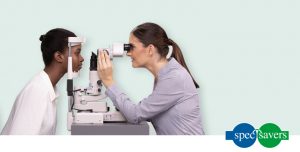Reading this — no matter how large or small the font size is, no matter how dark the room is — will not permanently damage your eyes, as some eye myths will have you believe. The number of carrots you eat isn’t likely to affect your ability to read this, either.
You may know that crossing your eyes too often won’t get them stuck that way, but you may think that reading in a dimly lit room will lead you to early nearsightedness. It’s important to separate fact from fiction, especially when the topic is eyesight. Knowing how to care for your eyes is the first step in protecting your sight. Don’t be blind to the facts—below are common myths about vision and facts.
Myth: Failure to use proper glasses will hurt your eyes
Fact: Wearing the wrong prescription glasses won’t damage your eyes permanently, but it can cause discomfort and temporary issues like headaches, eye strain, and blurred vision. Always consult an eye care professional to ensure you have the correct prescription for optimal eye health.
Myth: Using glasses for an extended period will cause your vision to deteriorate, leading to dependence on corrective lenses
Fact: Wearing glasses does not cause your vision to deteriorate or make you dependent on corrective lenses. Glasses correct your vision while you wear them. Any changes in your vision are likely due to natural ageing or underlying eye conditions, not from wearing glasses.
People’s eyes deteriorate with age, and someone who needed reading glasses at 40 is likely to need a stronger prescription at 50—whether they’ve been using glasses or not.
Myth: Reading in dim light or reading too much fine print will eventually harm your vision
Fact: While reading in the dark or the fine print can cause temporary eye strain and, possibly, a headache, it won’t harm your vision in the long term. It’s like saying the camera will be damaged if you take a picture in poor light. This is one of the most widely held myths about vision. Good lighting and regular breaks can help reduce eye strain.
Myth: Watching television for too long or sitting too close can damage your eyes
Fact: Watching television for extended periods or sitting too close to the screen won’t cause permanent damage to your eyes. However, it can lead to temporary eye strain or discomfort. Young children often sit close to the television screen because they can focus more on objects closer to their eyes than adults.
Children should have regular eye exams early to diagnose eye problems, such as nearsightedness (myopia). To reduce eye strain, take regular breaks, ensure proper lighting, and maintain a comfortable viewing distance.
Myth: Eating carrots will improve your vision
Fact: While it is true that carrots, as well as many other vegetables, are rich in vitamin A, which is essential for good eye health, eating them won’t improve your vision beyond its standard capacity. A balanced diet with various nutrients is vital in maintaining overall eye health.
Myth: Wearing contacts prevents nearsightedness from getting worse
Fact: Wearing contact lenses does not worsen nearsightedness (myopia). Contact lenses correct your vision while you wear them, but they do not stop or slow the progression of myopia. Regular eye check-ups and following your eye care professional’s advice are essential for managing myopia.
Myth: Cataracts can be removed with a laser
Fact: Cataracts—cloudy lenses in the eye—are typically removed through a surgical procedure called phacoemulsification. In this procedure, the cloudy lens is broken up using ultrasound and replaced with an artificial lens. While lasers can assist in specific surgery steps, they do not remove cataracts.
Myth: An eye examination is necessary only if you’re having problems
Fact: Regular eye examinations are essential even if you’re not experiencing any problems. Routine check-ups can detect early signs of eye conditions (glaucoma and macular degeneration) and other health issues (diabetes and hypertension), ensuring timely treatment and maintaining eye health. Children should be tested at birth, at six months, before entering school and periodically throughout the school years.
Myth: There’s nothing you can do to prevent vision loss
Fact: Over 90% of eye injuries can be prevented with simple and relatively inexpensive safety precautions. That means choosing the correct eye safety glasses for the job and wearing them 100% of the time. Protecting your eyes from UV light, managing chronic conditions like diabetes, and avoiding smoking can all help preserve your vision.
Regular eye exams can also help save your sight. Early detection of vision problems is crucial to preventing vision loss from many eye diseases, especially diabetic retinopathy and glaucoma.












